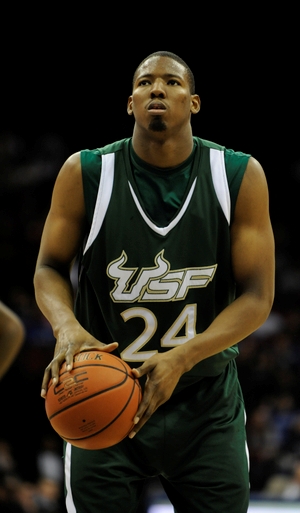
Jeff Rush
Gus Gilchrist came into the 2010-11 season as the clear offensive leader for South Florida after the departure of Dominique Jones. He held up his end of the bargain, leading the Bulls in scoring and finishing 2nd in rebounding, but struggled to lead his team to victories, as they won 10 fewer games than they did the year before. On top of that, he did not show significant progress in his skill level. Heading into his senior year, Gilchrist will have one more opportunity to take his game to the next level in Tampa.
Gilchrist possesses solid size and an intriguing frame for the next level, but is not a high level athlete by any measure. He plays the game almost exclusively below the rim and this often hurts his ability to finish in the paint -a legitimate concern as he progresses to the professional ranks.
As we pointed out last year, Gilchrist's game revolves around his jump shot. He hunts for jumpers, often leaving good position in the post or popping after setting a ball screen when a roll to the basket would have been the better play. He has not expanded his game the way that scouts had hoped and saw a significant drop in his shooting percentages when he became the primary offensive option in his junior year. Most of the 7% drop in his true shooting percentage can be attributed to his struggles from the three point line where he took a step back from the interesting efficiency he showed as a sophomore in a limited sample.
Gilchrist spends most of his time at the 4, which would be his position at the next level, and at 6'10 he is one of the bigger power forwards in the Big East. Though this gives him a decided advantage over smaller power forwards in post-up situations, he tends to settle for shots away from the rim rather than using his physical tools down low. He does have the ability to make jumpers after facing up in the post, and will take advantage of slower opponents by putting the ball on the floor with simple drives to the rim, but lacks a degree of physical assertiveness on the block.
While Gilchrist's numbers may not have progressed significantly since his freshman year, he remains a capable offensive threat for a player his size, especially when you consider the number of looks he has to create for himself. According to Synergy Sports Technology, only 15% of the power forward's touches come off of basket cuts, an indictment of the ability of his guards to create easy looks for him.
Outside of his scoring arsenal, Gilchrist hasn't shown significant development in any one area, remaining essentially the same player he was as a freshman on a number of levels. His per-40 pace adjusted statistics are fairly stagnant across the board, and though his efficiency as a scorer has varied, the rest of his game has not, both qualitatively and on paper. He remains the same average rebounder who is not an impact defender or an eager passer.
Gilchrist is not a particularly intimidating defender at this point. As we've noted in the past, Gilchrist is not very quick laterally which makes him a liability on the perimeter. He also lacks the toughness and the explosiveness to cause problems as a defender in the post. It is clear by watching Gilchrist that his focus and effort are concentrated mostly on the offensive end of the floor, and an improvement on the glass and as a defender around the rim would be a significant plus for the rising senior.
Although he can be very effective on the offensive end of the court by using his size, length and ability to shoot the ball, Gilchrist has some things to work on to improve his draft stock. His game has not shown the type of improvement that you would want to see after his breakout freshman year. That being said, any player with the size, length, and ability to shoot the ball that Gilchrist possesses is certainly intriguing, and regardless of his progress this season, he is an ideal candidate for the Portsmouth Invitational Tournament.

























Comments